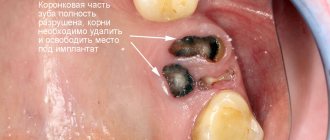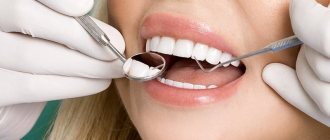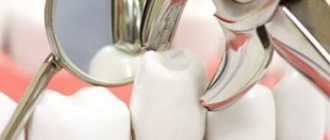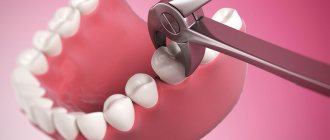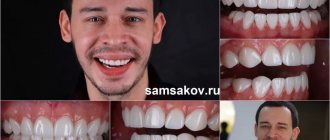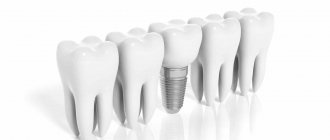Dental restoration through implantation followed by prosthetics is the most popular procedure in modern dentistry. Despite the seemingly high cost, implantation is completely justified and pays for itself after a couple of years by solving several problems at once. New artificial teeth perform all the stated functions, have an impeccable appearance and are indistinguishable from real teeth. High-quality dental implants last for decades; a fixed prosthesis does not cause discomfort and has good strength.
What is dental implantation?
Dental implantation involves the implantation of artificial roots into bone tissue, onto which a prosthesis or crown is subsequently attached.
The dental implant itself is a kind of screw (rod) that is immersed in the bone, acting as a tooth root. Dental implants have a diameter of 3 to 5 mm; titanium and zirconium oxide are most often used as materials for their production. The main property required of materials for dental implants is biocompatibility with human tissue. They should not cause the development of allergies and rejection reactions: otherwise, the operation will be ineffective and can lead to serious complications if assistance is not provided in a timely manner.
Dental implantation, when performed correctly, has very low risks associated with complications during the operation and the postoperative period. The protocols used in practice, medical equipment meets all standards of quality, reliability and safety. If you follow the technique of all stages, the rules of asepsis and antisepsis, and the absence of contraindications, implantation is the most accurate and reliable method of restoring both a single defect and the entire dentition.
Care after dental implantation
During the month after the procedure, you must follow important rules:
- Do not eat solid food.
- Avoid hot and cold drinks (any temperature changes are dangerous).
- Avoid going to the gym and swimming pool.
- Do not go to the bathhouse or sauna.
- Consume only soft and liquid foods (do not chew in the implant area).
- Brush your teeth with a soft toothbrush, using smooth movements.
- Avoid whitening toothpastes with abrasive particles.
- Make baths with an antiseptic composition.
- Lubricate the seams with protective paste before eating.
- Apply ice for the first 3-4 days in case of hematomas and swelling.
Note! After the procedure, check with your specialist for the names of all medications and the method of use to avoid complications.
Advantages of dental implantation
Implantation has so quickly gained popularity all over the world due to its following advantages:
- Durability: The service life of implants is more than 10-15 years. They do not require replacement if the prosthesis is damaged. A number of manufacturers offer a lifetime warranty on their implants.
- Meets all aesthetic requirements. The implant root in the jaw remains invisible to others, and the fixed prosthesis is difficult to distinguish from a real smile, and awkward questions from others can be avoided.
- There is no need to grind down or remove nerves from adjacent healthy teeth in a row, as, for example, when installing bridges.
- No discomfort, pain or vomiting. Fixed dentures are perceived as one’s own teeth, so a person does not experience any unpleasant sensations.
- No dietary restrictions. After installing the implants, you can gradually introduce a load of soft and then hard food.
- Psychological comfort: prosthetic structures do not fall out, there are no disturbances in diction or chewing.
Dental implantation is carried out in case of loss of one or more teeth, with a completely edentulous jaw. With the help of dental implants, the doctor is able to eliminate the consequences of mechanical injuries to the dental system.
First stage: installation of the implant into the bone
To form a bone bed in the patient’s jaw, the mucous membrane and periosteum are cut with a scalpel in the center of the alveolar ridge in the area of missing teeth. The mucoperiosteal flap is carefully peeled off, then the site of the bed preparation is marked. A hole in the jaw is drilled with a special fissure bur, which should be thinner in diameter than the implant. Before inserting the implant, the length, depth and width of the bone bed are measured.
The implant is inserted into the prepared bed with special tools (implant driver), and finally installed with 4-5 light blows of a hammer on the horizontal plane of the handle. In this case, reliable fixation of the implant is immediately achieved, thanks to its tension in the jaw bone, that is, the mechanical stress that occurs on its lateral surfaces.
The operation to install implants is carried out under both local and general anesthesia; the patient does not experience any pain. The whole procedure takes 10-15 minutes.
It takes some time for the implant to heal. On the upper jaw it is 2-6 months, and on the lower jaw – 2-4 months. These periods depend on bone density. At this stage, the implant may be under the gum. While the implant is healing, the missing tooth or teeth can be replaced with a temporary prosthesis.
Implantation stages
Dental implantation includes three main stages. The first is the preparatory stage: the success of the entire procedure depends on its completeness and quality of implementation. During the preparation process, the specialist:
- carefully collects complaints and anamnesis;
- conducts an examination of the oral cavity;
- prescribes additional examination methods: the patient must undergo a computed tomography scan before surgery to diagnose the condition of the dental system;
- determines the presence of absolute and relative contraindications to implantation;
- according to indications, recommends contacting a specialist of another profile to sanitize chronic foci of infection, normalize test results and the general condition of the body;
- Performs oral sanitation and professional hygiene.
High-quality preparation reduces the risk of complications during surgery and in the postoperative period. You can select the optimal model of a dental implant and its future location using 3D modeling: modern computer technologies allow you to do this quickly and as accurately as possible.
Next comes the surgical stage. During the operation, the doctor cuts or makes a puncture in the gum, through which the implant is immersed into the bone. The duration of this stage depends on the number of implant screws required by the patient to solve his problem: it can take from half an hour to several hours. Surgery is performed under local anesthesia; anesthesia is rarely required. Then the doctor installs a gum former, in place of which an abutment is installed after a couple of weeks.
The orthopedic stage is the final one. Based on individual impressions taken during the operation, a prosthesis is made. A permanent fixed prosthesis is installed 3-6 months (on average) after surgery: this is the time required for complete integration of the implant roots with the bone tissue. In order for the rehabilitation period to be as easy and natural as possible, it is important to choose a competent specialist: then all treatment will be successful and without complications.
Two-stage prosthetics with implants
Two-stage implantation is a classic method of prosthetics, in which, at the first stage, implants are installed on the patient, and the prostheses themselves are placed only a few months later, after the artificial root has engrafted and fused with the bone (osseointegration).
The peculiarity of the technique is that plugs are placed on the upper part of the implant, and the entire structure ends up under the gum and is not visually visible.
At the second stage, when the patient is fitted with dentures, the gum is re-incised, the abutment is screwed onto the post, and the crown is screwed onto it.
The two-stage protocol involves more trauma, but it has a number of advantages:
- optimal survival rate;
- long service life of implants;
- two-stage implantation is possible even when there are contraindications to a one-stage procedure;
- the ability to restore both one individual tooth and all teeth in a row;
- lower requirements for the condition of the dental system and the quality of bone tissue;
- fewer contraindications.
Contraindications
Dental implantation is an invasive procedure that has certain risks. There are a number of contraindications for its implementation:
- bone atrophy: in this case, volume is first increased, or special implants are used that are implanted into the zygomatic bone;
- some mental illnesses: consultation with a psychiatrist is required;
- oncological pathologies;
- diabetes mellitus: patients with this diagnosis have a high risk of rejection of implant rods;
- severe diseases of the hematopoietic system, heart pathologies;
- any infectious diseases in acute form: it is necessary to achieve remission or recovery;
- severe periodontitis and periodontal disease;
- HIV infection and other immunodeficiency conditions: the implant tooth simply does not take root;
- pregnancy and breastfeeding: hormonal changes can affect the healing of implant pins, so intervention is postponed for some time;
- age under 18 years: implants are not installed until adulthood due to the fact that the dental system has not fully formed.
All contraindications are identified at the first stage during questioning and examination, and additional diagnostic methods also help.
Four reasons to contact the CELT clinic for dental implantation
There are many advantages of contacting CELT. We list the main ones:
- Our specialists provide comprehensive information about implants and talk in detail about each stage of implantation. We carry out the process itself in such a way that the patient feels as comfortable as possible and understands exactly what actions the doctor performs at one time or another during treatment;
- Our specialists have modern equipment and technologies that allow us to create orthopedic structures that best match the “native” teeth;
- We use different types of anesthesia, so all procedures will be absolutely painless. We select anesthesia individually for each patient, taking into account the characteristics of his body;
- We use titanium implants made by leading manufacturers that have proven themselves in the global market: premium products “Astra Tech” and budget products “Implantium”.
Implants installed in the CELT Dentistry Department are imperceptible in the mouth, take root well, and the risk of damage is minimal. We will be glad to return your smile!
Types of dental implants
All types of dental implants are divided into two main groups: intraosseous and extraosseous. The first are the most common and are embedded in the bone tissue of the jaw. Extraosseous dental implants, as their name suggests, are fixed outside the bone in the oral cavity.
Intraosseous implants
This type of dental implants is divided into root-shaped, plate-shaped and combined.
Root-shaped implants are most often used by doctors in practical implantology. Externally, they are a screw made of biocompatible materials (mainly titanium). The titanium implant root is shaped like a tooth root and performs all its functions. Upon completion of osseointegration, the dental implant is firmly in place and can withstand the chewing load. To install an implant screw, a certain amount of bone tissue must be present: this is determined by the doctor during an examination before surgery. If the bone is loose, then the entire implant structure will be mobile and non-functional. To solve the problem of bone tissue atrophy, additional surgery is performed to increase the volume. In this case, the duration of treatment increases, but this is the only way to achieve the desired result.
Plate dental implants have a long and flat shape and are used for large defects. They are excellent for restoring front teeth due to the structure of the bone in this area, and also because this area does not bear heavy chewing load. Another advantage of plate implants is their cost: they will cost the patient 2-3 times less than root-shaped screws.
Combined implants are the best choice in difficult situations when the patient has multiple dental defects combined with insufficient bone tissue. Externally, they are a plate-root-shaped implant structure, which often has impressive dimensions and a complex shape. They are rarely installed, since their installation is very traumatic, accompanied by low survival rate and a long rehabilitation period.
Extraosseous dental implants
Extraosseous structures are installed when it is impossible to immerse intraosseous dental implants. They are also divided into several types:
- Subperiosteal - used for atrophy of the jaw bone, which is most often found in older people, as well as for long-term absence of teeth. Subperiosteal implants do not require a sinus lift because the screw is placed in the periosteum, which is located to the side of the gum. The installation of this type of dental implants is minimally traumatic; the screws themselves take root well and are firmly fixed in the oral cavity. Their disadvantage is that they do not satisfy the aesthetic needs of the client.
- Endodontic (stabilization) implants. They are a temporary measure, as they are attached to the natural root of the tooth. Because of this, the invasiveness of the procedure is reduced, but the short service life (despite good survival rates) makes their use in implantology extremely limited.
- Intramucosal dental implants are installed in the mucous membrane and are small in size and mushroom-shaped. With their help, the patient also manages to avoid the procedure of increasing the volume of bone tissue. Their disadvantage is their lack of strength and aesthetics. Used for fastening complete removable structures.
Root-shaped implants
Basal dental implants and mini-implants are used in special clinical cases when the use of other structures is not justified. They belong to root-shaped implants, but it is advisable to separate them into a separate group.
Basal implants differ from root implants in that they are placed somewhat deeper (in the basal and cortical layers of the bone). They have a lot of advantages, thanks to which they are actively being introduced into the practice of implantologists:
- can be used to restore teeth for people with insufficient bone tissue;
- possibility of immediate loading;
- When installing basal screws, a uniform distribution of the chewing load is achieved.
Mini-implants have a small diameter and size, but with such characteristics their strength and reliability do not suffer. The operation to implant mini-implants does not require an incision in the gums: a puncture of the mucous membrane is sufficient.
There is no universal implant screw that would be ideal in all cases. Only after questioning, a detailed examination and obtaining the results of additional examinations, the specialist selects the most appropriate implant option for installation, which will meet all the specified parameters.
All-on-4 and all-on-6 protocols
Speaking about what types of dental implantation exist, we cannot fail to mention technologies that allow you to restore the chewing functions of the jaw even in the absence of teeth.
This is an original development, in which the prosthetic structure is fixed to 4 or 6 implants, acting as supports.
If the patient has several of his teeth left, they are removed before prosthetics.
The procedure itself is carried out as follows:
- with the “all-on-4” technology, four implants with a removable abutment are implanted into the jaw: 2 - vertically in the central part of the jaw, and 2 - at an angle from 30 to 45 degrees in the lateral parts of the dentition;
- with the “all-on-6” protocol, six implants with a solid abutment are installed: 2 – vertically in the central part of the dental row, and 2 more on each side and also at an angle.
Placing the implants at an angle increases the area of contact with the bone and increases the level of fixation. In addition, installation at an angle allows the operation to be performed even with a limited amount of bone tissue without sinus lift.
Cost of different types of implantation
An important factor in choosing the type of implantation is the price. To make it easier for you to decide on the method of installing implants, we have indicated in the table below the approximate cost of all types of implantation that are in demand in modern dentistry. Therefore, you will not find prices for endodontic-endosseous, subperiosteal and transosseous techniques in it, since these types of implantation are no longer used.
| Type of implantation | Price for installation of one implant |
| Endosseous (intraosseous) implantation | 20 -35 thousand rubles. |
| Basal implantation | from 35 thousand rubles. |
| Intramucosal implantation | from 20 thousand rubles. |
| Laser implantation | 40 -60 thousand rubles. |
| Express implantation | from 40 thousand rubles. |
What implants and crowns do we install?
At the Dr. Levin dental center, only Nobel Biocare implants are used. We chose this system as one of the best - the implant survival rate is 99.3%.
Artificial roots are made of medical purified titanium. The surface with a porous structure of Ti-Unite in its chemical composition resembles a human tooth root, so the structures quickly take root. After 2 weeks, the jaw cells grow together with the installed artificial root without titanium oxidation. When manufacturing implants, vacuum casting technology is used without milling. The finished models are lightweight and therefore do not cause increased pressure on the bone.
For prosthetics, we use only metal-free crowns and bridges made using the Procera® method from Nobel Biocare or in our own digital production using Zirkonzahn Schule technology. We abandoned metal-ceramic prostheses a long time ago.
Metal-free crowns made of ceramics and zirconium dioxide are compatible with soft tissues, retain their shade during use, do not cause discomfort, and look like natural teeth.
Bridges consist of zirconium crowns and a titanium arch that unites the structure. To fix dentures on implants, Multi-unit abutments from Nobel Biocare are used.
What is the value of timely implantation?
Implantation allows you to eliminate aesthetic and functional problems associated with teeth in the most physiological way.
At the same time, the bone tissue of the jaws is preserved, which invariably undergoes atrophy after tooth extraction. Implants stop this process. The remaining healthy teeth remain intact.
Delaying implantation and prosthetics after tooth loss is not recommended for the following reasons:
- In the absence of several teeth, the bite and function of the masticatory muscles are disrupted for a long time, and the condition of the temporomandibular joint (TMJ) worsens. A characteristic crunching sound, aching pain at rest and sharp pain when chewing may appear. Developed TMJ diseases are usually extremely difficult to treat.
- The toothless area of the jaw quickly undergoes atrophy after removal.
- Neighboring teeth strive to compensate for the resulting defect in the dentition and begin to move towards each other. This gradually leads to pathology of the masticatory muscles and disruption of the movement of the lower jaw, and the TMJ suffers.
- Speech disturbances appear, such as a lisp.
- If there are no teeth, it is much more difficult to chew food thoroughly. Against this background, there is a high risk of developing problems with the digestive tract, as a result of impaired chewing function. The gums and cheeks are also injured.
- In the absence of a large number of teeth, an senile appearance appears - a change in the oval of the face, drooping of the corners of the lips and the appearance of wrinkles around the mouth.
- Psychological discomfort appears, which is associated with a defect in the dentition and loss of previous diction, an aesthetic defect.
- Decreased quality of life.
Before the procedure, the dentist will definitely conduct an examination: he will take a picture of the jaws, a computed tomography scan (3D picture), and get acquainted with the results of a blood test. Planning for future prosthetics is carried out in terms of aesthetics and function. This is necessary to achieve the best treatment result.


